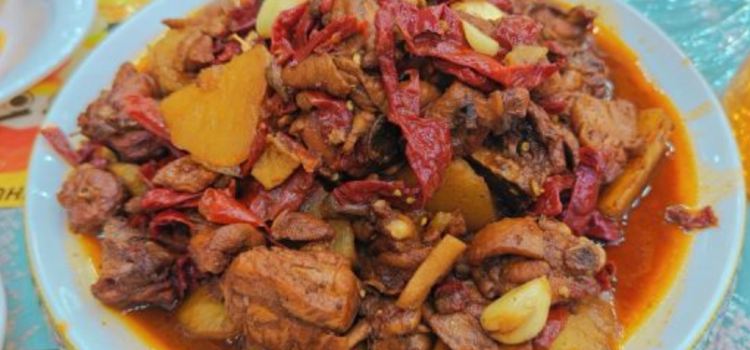JINZHU CHICKEN
5/54 Reviews
£6

2306857
What travelers say:

How can you not eat Dapanji when you come to Kashgar? It tastes different from Dapanji in other regions. It is very delicious when mixed with noodles.
More
Reviews of JINZHU CHICKEN
Some reviews may have been translated by Google Translate
5/5Outstanding
All (4)
Latest
Photo reviews (2)
Positive reviews (2)
How can you not eat Dapanji when you come to Kashgar? It tastes different from Dapanji in other regions. It is very delicious when mixed with noodles.
👉Sisters who are traveling to Xinjiang, please quickly save the following delicacies🉑️ 1⃣️Xinjiang baked buns The crispy skin contains large pieces of marinated beef, with just the right amount of cumin, soft and flavorful onions, and the most important thing is the finishing touch of sheep tail oil, which has no fishy smell and only leaves a charming aroma 📍Location: Opposite the Centennial Teahouse on Wustang Boyi Road (Aile Remu Meat Naan) 2⃣️Gangzi Meat It is a special delicacy of Xinjiang Uyghurs, a pocket version of the big pot of clear-boiled lamb. When making it, cut the mutton and carrots into small pieces and divide them into equal parts. Put them in porcelain jars and place them on the stove. After cooking, sprinkle some salt and you can enjoy the food. 📍Location: The intersection of Qiasha Road and Areya Road in Yawag Street 3⃣️Red Willow Kebabs For mutton kebabs, the most famous one is definitely the red willow mutton kebabs in southern Xinjiang. It is different from ordinary mutton skewers. The red willow mutton skewers are large in size, with rich aroma wrapping the mutton skin. It is juicy and delicious once you put it in your mouth. 📍Location: Urumqi Labor Street Night Market 4⃣️Big Plate Chicken This is Xinjiang’s number one food business card. If you eat in the mainland, you can always see Xinjiang Big Plate Chicken on the menu. However, only when you have eaten the authentic Xinjiang big plate chicken, you will know how delicious it is! 📍Location: Southeast of Bogra Community (Kuruk Tiereke Lane 2) (Jinzhu Dapanji) 5⃣️Baked naan In Xinjiang, naan is a belief. You can go a day without vegetables, but you can’t go a day without naan. If you hadn’t come to Xinjiang, you wouldn’t have known that naan has so many flavors! 📍Location: 376 Shengjia Community, Hongmiaozi Road, Sha District, Urumqi Next to (next to F910 bus residential community stop) 6⃣️Hand-pulled rice Mainly made with mutton! The key to whether a plate of pilaf is delicious lies in the mutton and mutton fat. The main ingredients of Xinjiang pilaf are rice, mutton, carrots, onions and mutton fat. Mix them and stew. The rice is shiny and has a strong aroma. ◎📍Location: Ailizati Zhua Fan Restaurant 7⃣️Horse Intestines This is a specialty of Yili. Yili smoked horse intestines are not greasy, with distinct lean and fat parts, firm meat, and a chewier texture than beef. Not only is it pleasing to the eye, but it is also highly nutritious and has a special flavor! 📍Location: 60 meters southeast of the intersection of Lane 12 of Gongren Street and Liguang Street 8⃣️ Stir-fried spicy lamb bones The lamb bones are covered with thick sauce, and the meat is connected to the tendons and has plenty of collagen. It is so satisfying to take a bite! You can even suck the bones after eating! 📍Uncle Afanti's authentic mutton skewers in Xinjiang Address: Golden Hawaii 84-170 9⃣️Xinjiang fried rice noodles The spicy Xinjiang fried rice noodles, the spicier the more you can't stop eating, the noodles are full of soup, and there are big pieces of chicken in it. A bowl of it is completely delicious. 📍Location: Dashizi subway station entrance (Lingling rice noodles) #新疆菜 #The Xinjiang food you can't miss #新疆美食攻略 #新疆美食探店
My favorite big plate spicy chicken in Xinjiang. A bit salty but very delicious.
Xinjiang, a land that occupies one-sixth of China's area, hides snow-capped mountains, grasslands, deserts, lakes and other extreme scenery, and is also a paradise for food lovers. In 2025, the tourism facilities here will be fully upgraded, and direct flights to Kanas and the new viewing platform on the Duku Highway are ready for you to explore. Want to know which places you must visit? Kanas Lake must not be missed. It is called "God's Back Garden". The lake water changes color with the light. In autumn, the golden birch forest and the blue lake water are beautiful like a painting. In 2025, you can also take a starry sky cruise and watch the Milky Way reflected on the lake during a night cruise. Arrange 2 days to visit Sanwan and Guanyutai to have fun. Sailimu Lake is known as "the last tear of the Atlantic Ocean". The lake water is clear and blue. From June to August, the lakeside is full of wild flowers. Drive to the "S-bend Highway" and stop. A casual shot is a movie-like picture. There will be a sailing festival in July 2025, and there will be a holographic projection station where you can see the history of road construction. It is best to go early in the morning or in the evening, and you can rent a bicycle to go around the lake for 50 yuan. Nalati Grassland is the "sky grassland", with green grass and wild flowers from June to August. You can stay in a Kazakh yurt and ride a horse to Xuelian Valley for about 200 yuan. However, there are many people in mid-July, so you can avoid the crowds if you enter the park early. Duku Highway is known as the "most beautiful highway in China". It is open from June to October and you can experience the four seasons in one day. Three new viewing platforms were added in 2025, and the middle section of the Gongnaisi River Valley section can be visited all year round. Please note that the northern section is not allowed to leave from 10 pm to 6 am, and buses with more than 7 seats are not allowed to pass. Kashgar Ancient City is a "living thousand-year-old ancient city". You can listen to the old man playing the rewap in the old teahouse and see craftsmen making copperware in the alleys. In the off-season, you can rent Uyghur costumes for 50 yuan a day to take pictures, and you can feel the fireworks of the ancient city in the evening. Speaking of food, the red willow barbecue at Urumqi International Grand Bazaar is 5 yuan per skewer, and the grilled buns with salty milk tea are perfect; the Baierkaiti meat naan at Consulate Alley is 3 yuan each, and the fried meat noodles at the Hand-rubbed Noodle King can be refilled for free; the Jinzhu big plate chicken at Hotan Second Street is enough for 3 people in a small portion. The prefectures and cities also have their own characteristics. The roasted pigeon at the Kashgar Khan Palace Night Market is 15 yuan per piece, paired with mint tea from a century-old teahouse; the Gulandam pistachio ice cream at Yining Liuxing Street is 12 yuan per ball, which goes well with Russian black bread; the grilled dogfish at the Burqin River Embankment Night Market is crispy on the outside and tender on the inside, and is just right with iced kvass. However, please note that many of the so-called "Hotan Jade Dates" in the night market are from Hebei, and Xinjiang dates must be identified as Ruoqiang gray dates; camel milk can easily cause diarrhea, so don't try it if you have a bad stomach; the first time you eat grilled lamb buns, buy half a bun to try, the authentic lamb filling may have a strong smell. When traveling to Xinjiang, you need to pay attention to documents and security checks. You must bring your ID card. You also need a border defense pass to go to border areas such as Kanas and Tashi County. In 2025, you can apply for it on the "Xinjiang Public Security" APP 15 days in advance. Tourists from Hong Kong, Macao and Taiwan have to ask travel agencies to apply for it. In terms of climate, "wearing a cotton jacket in the morning and a gauze in the afternoon" is the norm. Even in summer, you must bring thin down, sun-proof clothes and quick-drying T-shirts. The ultraviolet rays here are strong, so you must prepare sunglasses, SPF50 sunscreen and sun hats. In terms of transportation and accommodation, if you drive yourself, there may be snow on the Duku Highway in June, and there are sandstorms in the Taklimakan Desert. Be sure to check the road conditions before departure; accommodation in popular scenic spots such as Kanas and Hemu must be booked 3 months in advance, and the Hemu cabin should be selected with heating; 4 people sharing an SUV is cost-effective, and the average fare per person for 7 days is about 1,500 yuan. Cultural etiquette should not be forgotten. Before taking pictures of Uyghur children, you must say "Aksim" and obtain the consent of their parents. You cannot take pictures inside the mosque, and you must bypass people who are worshipping. You can bargain when buying things in the Grand Bazaar. It is best to buy valuable items such as jade and medicinal materials with people who know the business. Environmental protection and safety are equally important. You cannot pick up stones casually in Keketuohai, and you cannot litter cigarette butts in Kanas, otherwise you may be fined. Remember to bring folding garbage bags. When going to the Pamir Plateau, prepare a portable oxygen cylinder, which costs 25 yuan per can. How to plan the itinerary? The 7-day classic loop in northern Xinjiang can start from Urumqi, go to Tianshan Tianchi, Keketuohai, Kanas, Hemu, Sailimu Lake, Yili, and Nalati Grassland, and finally take the Duku Highway back to Urumqi. It is best to go from June to September or from September to October. The average cost per person is 6,000 to 8,000 yuan including air tickets. The 6-day cultural route in southern Xinjiang starts from Kashgar and goes to Baisha Lake, Muztagh Peak, Tashkurgan County, Hotan, Desert Highway, Kuche, and Kizil Thousand Buddha Caves. It is suitable to go from April to June or from September to October. Finally, a small suggestion is to find a local tour guide to make the journey more comfortable. For example, the tour guide Xia Xia can help with carpooling, booking accommodation, and planning routes. The 8-day trip costs only 1,500 yuan per person. When the sunset on the Duku Highway shines into the car window, and when the piano music in the old city of Kashgar floats over the earthen walls, you will understand that the beauty of Xinjiang is far more than just in the check-in list, but also in the feeling of freedom.